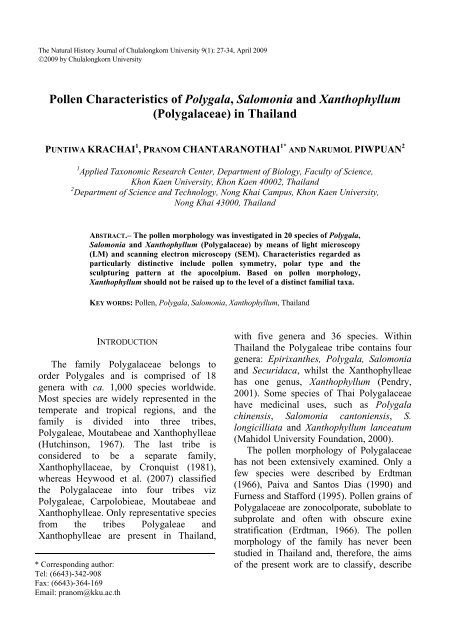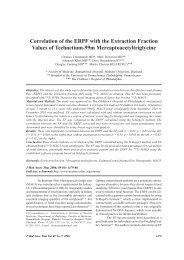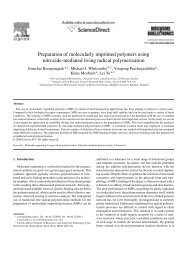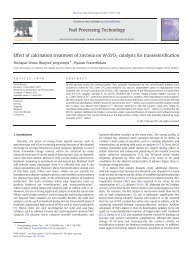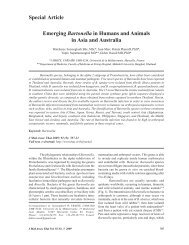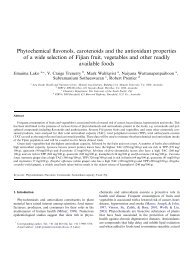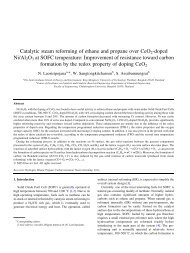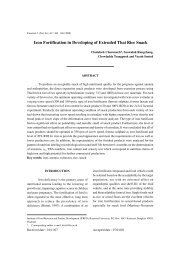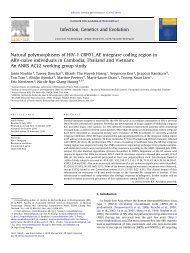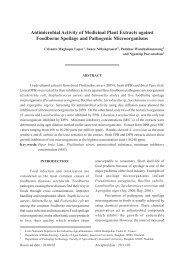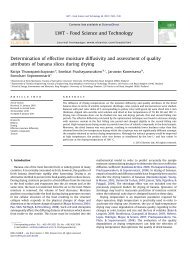Pollen Characteristics of Polygala, Salomonia and ... - ThaiScience
Pollen Characteristics of Polygala, Salomonia and ... - ThaiScience
Pollen Characteristics of Polygala, Salomonia and ... - ThaiScience
You also want an ePaper? Increase the reach of your titles
YUMPU automatically turns print PDFs into web optimized ePapers that Google loves.
The Natural History Journal <strong>of</strong> Chulalongkorn University 9(1): 27-34, April 2009<br />
©2009 by Chulalongkorn University<br />
<strong>Pollen</strong> <strong>Characteristics</strong> <strong>of</strong> <strong>Polygala</strong>, <strong>Salomonia</strong> <strong>and</strong> Xanthophyllum<br />
(<strong>Polygala</strong>ceae) in Thail<strong>and</strong><br />
PUNTIWA KRACHAI 1 , PRANOM CHANTARANOTHAI 1* AND NARUMOL PIWPUAN 2<br />
1 Applied Taxonomic Research Center, Department <strong>of</strong> Biology, Faculty <strong>of</strong> Science,<br />
Khon Kaen University, Khon Kaen 40002, Thail<strong>and</strong><br />
2 Department <strong>of</strong> Science <strong>and</strong> Technology, Nong Khai Campus, Khon Kaen University,<br />
Nong Khai 43000, Thail<strong>and</strong><br />
ABSTRACT.– The pollen morphology was investigated in 20 species <strong>of</strong> <strong>Polygala</strong>,<br />
<strong>Salomonia</strong> <strong>and</strong> Xanthophyllum (<strong>Polygala</strong>ceae) by means <strong>of</strong> light microscopy<br />
(LM) <strong>and</strong> scanning electron microscopy (SEM). <strong>Characteristics</strong> regarded as<br />
particularly distinctive include pollen symmetry, polar type <strong>and</strong> the<br />
sculpturing pattern at the apocolpium. Based on pollen morphology,<br />
Xanthophyllum should not be raised up to the level <strong>of</strong> a distinct familial taxa.<br />
KEY WORDS: <strong>Pollen</strong>, <strong>Polygala</strong>, <strong>Salomonia</strong>, Xanthophyllum, Thail<strong>and</strong><br />
INTRODUCTION<br />
The family <strong>Polygala</strong>ceae belongs to<br />
order Polygales <strong>and</strong> is comprised <strong>of</strong> 18<br />
genera with ca. 1,000 species worldwide.<br />
Most species are widely represented in the<br />
temperate <strong>and</strong> tropical regions, <strong>and</strong> the<br />
family is divided into three tribes,<br />
Polygaleae, Moutabeae <strong>and</strong> Xanthophylleae<br />
(Hutchinson, 1967). The last tribe is<br />
considered to be a separate family,<br />
Xanthophyllaceae, by Cronquist (1981),<br />
whereas Heywood et al. (2007) classified<br />
the <strong>Polygala</strong>ceae into four tribes viz<br />
Polygaleae, Carpolobieae, Moutabeae <strong>and</strong><br />
Xanthophylleae. Only representative species<br />
from the tribes Polygaleae <strong>and</strong><br />
Xanthophylleae are present in Thail<strong>and</strong>,<br />
* Corresponding author:<br />
Tel: (6643)-342-908<br />
Fax: (6643)-364-169<br />
Email: pranom@kku.ac.th<br />
with five genera <strong>and</strong> 36 species. Within<br />
Thail<strong>and</strong> the Polygaleae tribe contains four<br />
genera: Epirixanthes, <strong>Polygala</strong>, <strong>Salomonia</strong><br />
<strong>and</strong> Securidaca, whilst the Xanthophylleae<br />
has one genus, Xanthophyllum (Pendry,<br />
2001). Some species <strong>of</strong> Thai <strong>Polygala</strong>ceae<br />
have medicinal uses, such as <strong>Polygala</strong><br />
chinensis, <strong>Salomonia</strong> cantoniensis, S.<br />
longicilliata <strong>and</strong> Xanthophyllum lanceatum<br />
(Mahidol University Foundation, 2000).<br />
The pollen morphology <strong>of</strong> <strong>Polygala</strong>ceae<br />
has not been extensively examined. Only a<br />
few species were described by Erdtman<br />
(1966), Paiva <strong>and</strong> Santos Dias (1990) <strong>and</strong><br />
Furness <strong>and</strong> Stafford (1995). <strong>Pollen</strong> grains <strong>of</strong><br />
<strong>Polygala</strong>ceae are zonocolporate, suboblate to<br />
subprolate <strong>and</strong> <strong>of</strong>ten with obscure exine<br />
stratification (Erdtman, 1966). The pollen<br />
morphology <strong>of</strong> the family has never been<br />
studied in Thail<strong>and</strong> <strong>and</strong>, therefore, the aims<br />
<strong>of</strong> the present work are to classify, describe
28<br />
<strong>and</strong> illustrate the pollen morphology <strong>of</strong> the<br />
Thai <strong>Polygala</strong>ceae.<br />
MATERIALS AND METHODS<br />
The pollen from 20 taxa <strong>of</strong> <strong>Polygala</strong>ceae<br />
in Thail<strong>and</strong> were collected in the field by the<br />
third author <strong>and</strong> examined by light<br />
microscopy (LM) <strong>and</strong> scanning electron<br />
microscopy (SEM). The pollen was prepared<br />
according to the st<strong>and</strong>ard method <strong>of</strong><br />
acetolysis (Erdtman, 1966). For LM, pollen<br />
was mounted in silicone oil <strong>and</strong> sealed with<br />
paraffin. Measurements were based on 15<br />
pollen grains per species. The polar axis (P),<br />
equatorial axis (E), exine thickness (EX),<br />
NAT. HIST. J. CHULALONGKORN UNIV. 9(1), APRIL 2009<br />
TABLE 1. <strong>Pollen</strong> morphology <strong>of</strong> Thai <strong>Polygala</strong>ceae (Apo = apocolpium, CL = colpi length, E =equatorial axis,<br />
Ex = exine thickness, Me = mesocolpium, SP = sculpturing pattern, P = polar axis, ret = reticulate, retD =<br />
reticulate with depression, rug = rugulate).<br />
Taxa Type Polarity Symmetry Amb shape P (µm)<br />
Tribe Polygaleae<br />
<strong>Polygala</strong><br />
<strong>Polygala</strong> section Pseudosemeiocardium<br />
P. cardiocarpa G-I heteropolar bilateral oblate oblate 23-29 (26.3±1.9)<br />
P. malesiana G-I heteropolar bilateral oblate oblate 25-30 (27.8±1.6)<br />
P. umbonata G-I heteropolar bilateral oblate oblate 13-20 (17.9±1.7)<br />
<strong>Polygala</strong> section Chamaebuxus<br />
P. arillata G-IITIIA isopolar radial circular suboblate 42-51 (46.1±2.3)<br />
P. karensium G-I heteropolar bilateral oblate oblate 34-46 (41.0±3.4)<br />
P. venenosa G-IITIIB isopolar radial circular subprolate 50-64 (56.1±4.4)<br />
<strong>Polygala</strong> section <strong>Polygala</strong><br />
P. chinensis G-IITIIA isopolar radial circular subprolate 29-39 (33.8±2.6)<br />
P. erioptera G-IITI isopolar radial circular oblate-spheroidal 19-27 (22.0±2.0)<br />
P. longifolia G-IITIIA isopolar radial circular prolate 29-55 (39.0±8.8)<br />
P. persicariifolia G-IITI isopolar radial circular oblate-spheroidal 32-38 (34.6±1.7)<br />
P. polifolia G-IITI isopolar radial circular prolate 31-44 (40.8±4.0)<br />
P. triflora G-IITIIA isopolar radial circular subprolate 37-46 (40.8±3.9)<br />
<strong>Salomonia</strong><br />
S. cantoniensis G-IITI isopolar radial circular subprolate 30-39 (33.0±2.6)<br />
S. ciliata G-IITI isopolar radial circular oblate-spheroidal 33-40 (35.0±2.0)<br />
S. kradungensis G-IITI isopolar radial circular oblate-spheroidal 37-48 (41.3±3.0)<br />
S. longiciliata G-IITI isopolar radial circular oblate-spheroidal 27-35 (31.2±2.8)<br />
S. thail<strong>and</strong>ica G-IITI isopolar radial circular oblate-spheroidal 35-48 (40.4±3.2)<br />
Tribe Xanthophylleae<br />
Xanthophyllum<br />
X. ellipticum G-IITIIB isopolar radial circular prolate-spheroidal 26-33 (28.8±1.7)<br />
X. geesinkii G-IITIIB isopolar radial circular suboblate 22-29 (24.8±1.8)<br />
X. lanceatum G-IITIIB isopolar radial circular oblate-spheroidal 25-33 (28.2±2.8)<br />
colpus length (CL) <strong>and</strong> number <strong>of</strong> colpi (NC)<br />
were recorded. For SEM, acetolysed pollen<br />
grains were suspended in a drop <strong>of</strong> absolute<br />
alcohol, then transferred to stubs <strong>and</strong> coated<br />
with gold-palladium mixture. SEM<br />
micrographs were taken with Leo 1450VP<br />
SEM. Descriptive terminology is according<br />
to Erdtman (1966).<br />
RESULTS<br />
General pollen description<br />
The family <strong>Polygala</strong>ceae pollen is<br />
monad, isopolar or heteropolar, radially or<br />
bilaterally symmetric, zonocolporate, small<br />
to large-sized (P =13 - 64 µm, E = 20 - 78<br />
µm) <strong>and</strong> oblate to prolate in shape. The
KRACHAI ET AL. — POLYGALACEAE POLLENS IN THAILAND 29<br />
TABLE 1. Cont.<br />
E (µm)<br />
Number <strong>of</strong><br />
apertures<br />
exine stratification is mostly obscure, 1 - 10<br />
µm in thickness. The pollen has a psilate<br />
surface on the mesocolpium. Three exine<br />
sculpturing patterns at the apocolpium are<br />
present within the genera studied. All<br />
species in the <strong>Polygala</strong> section<br />
Pseudosemeiocardium <strong>and</strong> P. karensium<br />
have aperturoid depression, whereas psilate<br />
is found in all species <strong>of</strong> P. arillata, P.<br />
chinensis, P. longifolia, P. triflora, P. venenosa<br />
<strong>and</strong> Xanthophyllum, <strong>and</strong> reticulate or<br />
reticulate-rugulate is found in most species<br />
<strong>of</strong> <strong>Polygala</strong> section <strong>Polygala</strong>. The pollen<br />
morphology is summarized in Table 1.<br />
<strong>Polygala</strong>: The pollen grains are mostly<br />
oblate or subprolate, less frequently oblatespheroidal,<br />
prolate or suboblate, P = 13 - 64<br />
µm; E = 20 - 78 µm. The number <strong>of</strong><br />
CL (µm) Ex (µm)<br />
SP<br />
Me Apo<br />
44-58 (51.0±3.8) 20-24 (21.8±1.3) 12-16 (13.8±1.3) 2-3 (2.1±0.3) psilate retD<br />
48-66 (54.1±4.4) 24-29 (27.6±1.4) 13-18 (15.2±1.7) 2-3 (2.2±0.4) psilate retD<br />
30-37 (34.3±2.3) 22-27 (24.4±1.6) 7-11 (8.8±1.01) 1-2 (1.8±0.2) psilate retD<br />
49-57 (53.4±2.8) 16-20 (17.3±0.9) 30-38 (33.6±1.8) 6-10 (7.1±1.3) psilate psilate<br />
58-78 (67.8±7.2) 19-21 (20.2±0.6) 19-30 (24.7±4.0) 3-5 (4.3±0.6) psilate retD<br />
40-49 (44±3.2) 11-14 (12.4±1.0) 33-40 (35.8±2.3) 3-6 (4.4±0.9) psilate psilate<br />
26-33 (28.0±3.1) 20-22 (21.4±1.0) 22-32 (25.3±2.8) 4-6 (5.0±0.5) psilate psilate<br />
20-28 (23.0±2.0) 17-22 (19.0±1.7) 16-22 (17.9±1.4) 3-5 (4.0±0.5) psilate ret<br />
22-29 (23.6±1.7) 21-27 (24.0±2.0) 5-10 (6.8±1.5) 5-6 (5.3±0.4) psilate psilate<br />
31-40 (34.6±3.1) 15-18 (16.6±0.8) 23-29 (25.0±1.5) 4-7 (5.2±0.7) psilate ret<br />
22-28 (24.0±1.6) 25-30 (27.2±1.4) 20-32 (26.6±3.6) 5-7 (5.8±0.6) psilate ret<br />
30-39 (33.8±2.9) 19-23 (21.4±1.1) 25-32 (27.2±2.3) 5-8 (6.6±0.8) psilate psilate<br />
23-30 (25.3±2.0) 18-23 (21.1±1.1) 19-28 (23.0±2.6) 3-6 (5.0±0.8) psilate ret-ru<br />
31-41 (35.9±2.7) 12-16 (13.9±1.0) 20-26 (23.0±2.0) 4-7 (5.8±0.9) psilate ret-ru<br />
33-48 (42.7±4.7) 12-14 (12.5±0.6) 21-33 (27.93±3.0) 5-8 (6.2±1.0) psilate ret-ru<br />
28-38 (33.3±2.6) 10-13 (12.1±0.6) 17-23 (20.2±1.5) 4-7 (5.0±0.8) psilate ret-ru<br />
36-50 (41.4±3.9) 11-13 (12.4±0.6) 20-31 (25.3±3.5) 5-9 (6.7±1.1) psilate ret-ru<br />
23-29 (26.0±1.8) 7-9 (8.13±0.5) 19-25 (21.2±1.7) 2-4 (2.6±0.5) psilate psilate<br />
28-32 (29.4±1.4) 9-10 (9.7±0.4) 16-21 (18.2±1.2) 4-5 (4.6±0.5) psilate psilate<br />
26-37 (31.5±3.4) 9-11 (9.7±0.7) 19-25 (20.9±1.9) 2-5 (3.4±0.7) psilate Psilate<br />
apertures varies from 11 - 30 with 5 - 40 µm<br />
long colpi<strong>and</strong> 1 - 10 µm thick exines (Fig.<br />
1A - L).<br />
<strong>Salomonia</strong>: The pollen grains are mostly<br />
oblate-spheroidal, rarely subprolate, P = 27 -<br />
48 µm; E = 23 - 50 µm. The number <strong>of</strong><br />
apertures is 10 - 23 with 17 - 33 µm long<br />
colpi <strong>and</strong> 3 - 9 µm thick exines (Fig. 1M -<br />
Q).<br />
Xanthophyllum: The pollen grains are<br />
oblate-spheroidal, suboblate or prolatespheroidal,<br />
P = 22 - 33 µm; E = 23 - 37 µm.<br />
The number <strong>of</strong> apertures is 7 - 11 with 16 -<br />
25 µm long colpi <strong>and</strong> 2 - 5 µm thick exines<br />
(Fig. 1R - T).
30<br />
NAT. HIST. J. CHULALONGKORN UNIV. 9(1), APRIL 2009<br />
FIGURE 1. LM micrographs showing <strong>Polygala</strong>ceae pollen in polar view <strong>and</strong> equatorial view. A) P. arillata, B) P.<br />
cardiocarpa, C) P. chinensis, D) P. erioptera, E) P. karensium, F) P. longifolia, G) P. malesiana, H) P. persicariifolia,<br />
I) P. polifolia, J) P. triflora, K) P. umbonata, L) P. venenosa, M) S. cantoniensis, N) S. ciliata, O) S. kradungensis, P)<br />
S. longiciliata, Q) S. thail<strong>and</strong>ica, R) X. ellipticum, S) X. geesinkii, T) X. lanceatum. Scale bars = 10 µm.
KRACHAI ET AL. — POLYGALACEAE POLLENS IN THAILAND 31<br />
DISCUSSION AND CONCLUSION<br />
The present study shows that the main<br />
characteristic features <strong>of</strong> pollen <strong>of</strong> <strong>Polygala</strong>,<br />
<strong>Salomonia</strong> <strong>and</strong> Xanthophyllum are isopolar,<br />
radially symmetric, suboblate to subprolate<br />
in shape, a zonocolporate aperture in all<br />
genera, with a variable number <strong>of</strong> apertures<br />
between <strong>and</strong> within species. The exine<br />
sculpturing pattern is psilate on the<br />
mesocolpium <strong>and</strong> with or without<br />
depression at the poles. These characters<br />
agree well with those reported earlier for<br />
<strong>Polygala</strong>ceae (Erdtman, 1966; Paiva &<br />
Santos Dias, 1990 <strong>and</strong> Furness & Stafford,<br />
1995). Furthermore, a heteropolar grain,<br />
bilateral symmetry, oblate or prolate in<br />
shape <strong>and</strong> reticulate or reticulate-rugulate<br />
sculpturing pattern at apocolpium are<br />
additional informative characters that have<br />
never been reported previously<br />
The pollen shape <strong>of</strong> all species studied<br />
was mostly circular in polar view <strong>and</strong><br />
oblate-spheroidal in equatorial view, but<br />
subprolate, suboblate, prolate or prolatespheroidal<br />
shapes can also be found in a few<br />
species.<br />
Two pollen groups can be established on<br />
the basis <strong>of</strong> the polar type <strong>and</strong> pollen<br />
symmetry.<br />
Group I: This group has heteropolar<br />
grain <strong>and</strong> bilateral symmetry. The pollen<br />
morphology <strong>of</strong> this group is represented in<br />
all species <strong>of</strong> the <strong>Polygala</strong> section<br />
Pseudosemeiocardium (P. cardiocarpa, P.<br />
malesiana <strong>and</strong> P. umbonata) <strong>and</strong> P.<br />
karensium in the section Chamaebuxus (Fig.<br />
2A - D), P = 13 - 46 µm, E = 30 - 78 µm.<br />
The smallest size was found in P. umbonata<br />
(P = 13 - 20 µm, E = 30 - 37 µm), <strong>and</strong> the<br />
largest in P. karensium (P = 34 - 46 µm, E =<br />
58 - 78 µm). The number <strong>of</strong> apertures varied<br />
from 19 to 29, the exine is 1-5 µm thick<br />
with a psilate sculpturing pattern on the<br />
mesocolpium but a reticulate sculpturing<br />
pattern with depression at the apocolpium.<br />
The members <strong>of</strong> this group are also<br />
supported by anatomical studies. Piwpuan<br />
(2007) reported that the leaf surface <strong>of</strong> this<br />
group has a unicellular trichome which is<br />
spine-like, but this does not agree well with<br />
the morphological classification.<br />
Group II: This group has an isopolar<br />
grain <strong>and</strong> radial symmetry, <strong>and</strong> can also be<br />
divided into 2 types based on the<br />
sculpturing pattern at the apocolpium.<br />
Type I: This type is characterized by a<br />
reticulate or a reticulate-rugulate<br />
apocolpium. The pollen is oblate-spheroidal<br />
to prolate in shape (P = 19 - 48 µm, E = 20 -<br />
50 µm). The number <strong>of</strong> apertures varies<br />
from 10 to 30 with a 3 - 9 µm thick exine<br />
that has a psilate sculpturing pattern on the<br />
mesocolpium <strong>and</strong> a reticulate or reticulaterugulate<br />
pattern at the apocolpium. P.<br />
polifolia tends to have more apertures than<br />
the other members <strong>of</strong> this type (25-30 vs 10-<br />
23).<br />
This type comprises all members <strong>of</strong><br />
<strong>Salomonia</strong> <strong>and</strong> three species <strong>of</strong> <strong>Polygala</strong>, P.<br />
erioptera, P. persicariifolia <strong>and</strong> P. polifolia<br />
(Fig. 2E - L).<br />
Type II: This type is characterized by a<br />
psilate apocolpium. The pollen is suboblate<br />
to prolate in shape (P = 22 - 64 µm, E = 22 -<br />
57 µm). The number <strong>of</strong> apertures is 7 - 27<br />
<strong>and</strong> the exine is 2 - 10 µm thick. Two<br />
subtypes can be established based on the<br />
number <strong>of</strong> apertures.<br />
Subtype A: This subtype has 16 - 27<br />
apertures <strong>and</strong> contains P. arillata, P.<br />
chinensis, P. longifolia <strong>and</strong> P. triflora. P.<br />
longifolia has the shortest colpi which<br />
ranges from 5 - 10 µm (Fig. 3A-D).<br />
Subtype B: This subtype has a small<br />
number <strong>of</strong> apertures, 7 - 14, <strong>and</strong> contains all
32<br />
the examined species <strong>of</strong> Xanthophyllum plus<br />
P. venenosa. (Fig. 3E - H). The presence <strong>of</strong><br />
sclereid cells on the ground tissue <strong>of</strong> the<br />
NAT. HIST. J. CHULALONGKORN UNIV. 9(1), APRIL 2009<br />
FIGURE 2. SEM micrographs <strong>of</strong> pollen. Group I (A-D) <strong>and</strong> Group II Type I (E-L): A) P. cardiocarpa,<br />
equatorial view showing reticulate with depression at apocolpia <strong>and</strong> apertures. B) P. karensium, subequatorial<br />
view showing reticulate with depression at apocolpium <strong>and</strong> apertrues. C) P. malesiana, equatorial view<br />
showing reticulate with depression at apocolpia <strong>and</strong> apertures. D) P. umbonata, subpolar view showing<br />
reticulate with depression at apocolpium <strong>and</strong> apertures. E) P. erioptera, subequatorial view showing reticulate<br />
apocolpium <strong>and</strong> apertures. F-G) Equatorial view showing apertures <strong>and</strong> reticulate apocolpia <strong>and</strong> apertures, F)<br />
P. persicariifolia. G) P. polifolia. H) S. cantoniensis, subpolar view showing reticulate-rugulate apocolpium.<br />
I) S. ciliata, equatorial view showing apertures <strong>and</strong> reticulate-rugulate apocolpium. J-L.) Subpolar view<br />
showing reticulate-rugulate apocolpium <strong>and</strong> apertures, J) S. kradungensis, K) S.longiciliata, L) S. thail<strong>and</strong>ica.<br />
Scale bars = 10 µm.<br />
stem <strong>and</strong> a similar pattern <strong>of</strong> the vascular<br />
tissues in the floral part supports the
KRACHAI ET AL. — POLYGALACEAE POLLENS IN THAILAND 33<br />
FIGURE 3. SEM micrographs <strong>of</strong> pollen. Group II Type II subtype A (A-D) <strong>and</strong> Group II Type II subtype B<br />
(E-H): A) P. arillata, subequatorial view showing psilate apocolpia <strong>and</strong> apertures. B-C) Subequatorial view<br />
showing psilate apocolpia <strong>and</strong> apertures, B) P. chinensis, C) P. longifolia. D) P. triflora, equatorial view<br />
showing psilate apocolpia <strong>and</strong> apertures. E) P. venenosa, polar view showing psilate apocolpium. F) X.<br />
ellipticum, subpolar view showing psilate apocolpium. G) X. geesinkii, equatorial view showing apertures <strong>and</strong><br />
psilate at apocolpia. H) X. lanceatum, subpolar view showing psilate apocolpium. Scale bars = 10 µm.<br />
grouping <strong>of</strong> P. venenosa <strong>and</strong> Xanthophyllum<br />
(Piwpuan, 2007; Eriksen, 1993).<br />
The palynological <strong>and</strong> anatomical studies<br />
suggest that Xanthophyllum should be treated<br />
as a genus within <strong>Polygala</strong>ceae. However,<br />
more taxa need to be examined <strong>and</strong><br />
alternative techniques, such as perhaps<br />
molecular systematic approaches, are needed<br />
to clarify the infrageneric taxa <strong>of</strong> this family.<br />
ACKNOWLEDGEMENTS<br />
This work was supported by the Applied<br />
Taxonomic Research Center, Department <strong>of</strong><br />
Biology, Faculty <strong>of</strong> Science, Khon Kaen<br />
University.
34<br />
LITERATURE CITED<br />
Cronquist, A. 1981. An integrated system <strong>of</strong><br />
classification <strong>of</strong> flowering plants. Columbia<br />
University Press, New York.<br />
Erdtman, G. 1966. <strong>Pollen</strong> Morphology <strong>and</strong> Plant<br />
Taxonomy Angiosperms. Hafner Publishing<br />
Company, New York.<br />
Eriksen, B. 1993. Floral anatomy <strong>and</strong> morphology in<br />
the <strong>Polygala</strong>ceae. Plant Systematics <strong>and</strong> Evolution,<br />
186: 17-32.<br />
Furness, S.H. <strong>and</strong> Stafford, P.J. 1995. The Northwest<br />
European <strong>Pollen</strong> Flora, 55; <strong>Polygala</strong>ceae.Review <strong>of</strong><br />
Palaeobotany <strong>and</strong> Palynology, 88: 61-82.<br />
Heywood, V.H., Brummitt, R.K., Culham, A. <strong>and</strong><br />
Oseberg, O. 2007. Flowering Plant Families <strong>of</strong> the<br />
World. Royal Botanic Gardens, Kew.<br />
Hutchinson, J. 1967. The Genera <strong>of</strong> Flowering Plants<br />
(Angiospermae): Dicotyledons, vol. II. Oxford<br />
University Press.<br />
Mahidol University Foundation. 2000. Encyclopedia <strong>of</strong><br />
herbal medicine, vol. 4 Kok Ya Esarn. 1 st ed.<br />
Amarin Printing <strong>and</strong> publishing Public Co. Ltd.,<br />
Bangkok.<br />
Paiva, J. <strong>and</strong> Santos Dias, J.D. 1990. The pollen grain<br />
<strong>of</strong> <strong>Polygala</strong> fruticosa Berg. (<strong>Polygala</strong>ceae). Anales<br />
del Jardín Botánico de Madrid, 47(2): 377-385.<br />
Pendry, C.A. 2001. <strong>Polygala</strong>ceae. In: Flora <strong>of</strong> Thail<strong>and</strong>.<br />
T. Santisuk <strong>and</strong> K. Larsen (Eds.). Prachachom Co.<br />
Ltd., Bangkok. Vol. 7, part 3, pp. 498-538.<br />
Piwpuan, N. 2007. Comparative Anatomy <strong>of</strong><br />
<strong>Polygala</strong>ceae in Thail<strong>and</strong>. Master <strong>of</strong> Science Thesis<br />
in Biology, Graduate School, Khon Kaen<br />
University, Thail<strong>and</strong>.<br />
Received: 24 November 2008<br />
Accepted: 17 January 2009<br />
NAT. HIST. J. CHULALONGKORN UNIV. 9(1), APRIL 2009<br />
APPENDIX<br />
SPECIMENS EXAMINED<br />
The species are enumerated in<br />
alphabetical order. All specimens examined<br />
are deposited at Khon Kaen University<br />
Herbarium (KKU); <strong>Polygala</strong> arillata Buch.-<br />
Ham. ex D.Don, Narumol 24. -P.<br />
cardiocarpa Kurz, Narumol 101. -P.<br />
chinensis L., Narumol 21. -P. erioptera DC.,<br />
Narumol 97. -P. karensium Kurz, Narumol<br />
19. -P. longifolia Poir., Narumol 23. -P.<br />
malesiana Adema, Narumol 60. -P.<br />
persicariifolia DC., Narumol 95. -P. polifolia<br />
C.Presl, Narumol 61. -P. triflora L., Narumol<br />
81. -P. umbonata Craib, Narumol 90. -P.<br />
venenosa Juss. ex Poir., Narumol 42. -<br />
<strong>Salomonia</strong> cantoniensis Lour., Narumol 26. -<br />
S. ciliata (L.) DC., Narumol 59. -S.<br />
kradungensis H. Koyama, Narumol 88. -S.<br />
longiciliata Kurz, Narumol 22. -S.<br />
thail<strong>and</strong>ica H.Koyama, Narumol 80. -<br />
Xanthophyllum ellipticum Korth. ex Miq.,<br />
Narumol 50. -X. geesinkii Meijden, Narumol<br />
37. -X. lanceatum (Miq.) J.J.Sm., Narumol<br />
36.


